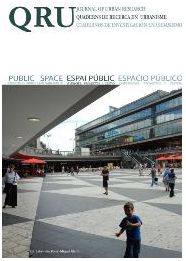Cantonades metropolitanes, racons domèstics: sobre la condició d’urbà de l’espai de la mobilitat
DOI:
https://doi.org/10.5821/qru.9544Abstract
Transport people, goods and energy networks are the structural basis of the progress in metropolitan areas. Usually the criteria of design of these networks, transport channels and traffic junctions, are determined by the safety of users and economic efficiency. In the case of segregated mobility, highway and railway networks, technical rules for drawing routes cause frictions between infrastructural networks and land. Mobility space, beyond strict limits of the transport path or legal reserves, should agree with transport network and territory. Functional segregation of mobility and activities, stimulated by Modern Movement, is the basis for urban policies in the second half of the twentieth century. Reconciling the right to mobility and the right to territory involves dealing social and economic development at the same time that encouraging local values. Coordination between transport systems, particularly in transport nodes, and human activity should allow both the optimization of land uses and at the same time minimizing the environmental impact. Transfer nodes, railway stations and traffic junctions, are places of centrality in metropolitan areas: new metropolitan corners. Crossroads for exchanging take part into a dual reality: transport network and territory. Urbanity at the node depends on ability to establish agreements between environment and users, at both metropolitan and local level. Civic-minded appropriation of public space of the metropolitan mobility is based on recognizing its domesticity, effective interaction between collective space and subject. The Randstad-Holland is a polycentric metropolis with a singular urban hierarchy in Western Europe. Transport networks have been shaping it since its origin, a fictitious land conditioned by Tabula rasa. Thinking the territory of the Delta from metropolitan corners is an exercise in vindication of their condition of places rather than infrastructural nodes. This strategy remains in the urban development of the Netherlands throughout history and therefore it constitutes a fundamental feature of its identity.Downloads
Issue
Section
License
Those authors who have publications with this journal, accept the following terms:
a. Authors will retain their copyright and guarantee the journal the right of first publication of their work, which will be simultaneously subject to the Creative Commons CC BY-NC-ND-4.0 recognition license that allows third parties to share the work provided that its author and its first publication are indicated in this journal, but they cannot be changed or used commercially.
b. Authors may adopt other non-exclusive license agreements for the distribution of the version of the published work (eg: deposit it in an institutional telematic archive or publish it in a monographic volume) provided that the initial publication in this journal is indicated.
c. Authors are allowed and recommended to disseminate their work through the Internet (e.g. in institutional telematic files or on their website) before and during the submission process, which can lead to interesting exchanges and increase citations. of the published work. (See The effect of open access).













